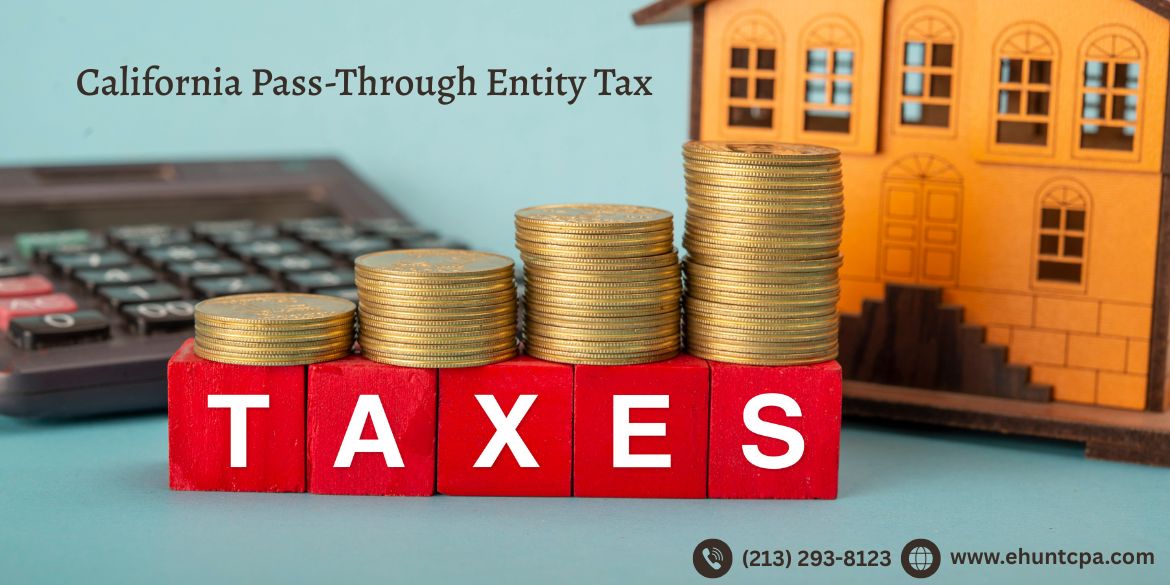
The California Pass-Through Entity Tax has quickly become a hot topic for business owners across the state. Introduced under Assembly Bill 150 (AB 150), the elective PTE tax gives partnerships, S corporations, and LLCs taxed as partnerships or S corporations a way to work around the federal SALT deduction cap.
This means many business owners could keep more of their hard-earned money. At Eric M Hunt, CPA, we make this complex tax election easier to understand and handle. We aim to help our clients get the most benefit possible while staying fully aligned with California Franchise Tax Board (FTB) rules and regulations.
This blog explains everything you need to know about the California PTE tax election, deadlines, eligibility, deductions, credits, forms, and key strategies for 2025 and beyond.
Introduction to California Pass-Through Entity Tax
The California Pass-Through Entity Tax is an elective tax that gives eligible businesses the option to pay state income tax at the entity level, rather than passing the responsibility entirely onto individual owners. The goal is to help owners of pass-through businesses work around the national $10,000 SALT (State and Local Tax) deduction limitation set by the 2017 Tax Cuts and Jobs Act.
Electing to pay the tax at the entity level allows business owners to apply a California PTE tax credit on their personal return, effectively restoring the limited SALT deduction. High-income taxpayers in California have found this strategy especially useful.
How the California PTE Tax Works
Here’s how it operates in practice:
- The pass-through entity may elect to pay California PTE tax at a 9.3% rate on the owner’s portion of net income.
- This payment decreases the income reported to owners for national purposes, effectively reducing their taxable income.
- Owners can then claim a California PTE tax credit on their state personal income tax return for their portion of the tax paid.
Example
Imagine a California S corporation with $1,000,000 in income, split evenly between its two shareholders. The company can choose to pay $46,000 in PTE tax, which is 9.3% of each shareholder’s $500,000 share. Each shareholder can later claim a $46,500 credit on their California state tax return.
This provides the advantage of a federal deduction benefit while ensuring you retain a credit at the state level for taxes already paid.
Eligible Entities for PTE Election
Not all businesses can take advantage of California’s pass-through entity election. Those who qualify include:
- Partnerships (general and limited)
- S Corporations
- Limited Liability Companies (LLCs) that file taxes like a partnership or an S corporation
Entities that cannot elect PTE tax:
- Single-owner businesses.
- Publicly traded partnerships.
- Entities with partnerships as owners (in some cases).
At Eric M Hunt, CPA, we take a close look at each entity’s structure to make sure it qualifies before filing an election.
California PTE Tax Election Process
To make the California PTE tax election, you must follow a precise process. Here’s what it looks like:
- Annual Election: The election needs to be held every year, and once chosen, it can’t be undone.
- File with Franchise Tax Board (FTB): Entities must submit the election through the appropriate forms and payment vouchers.
- Use California Form 3893: This form is the official PTE Elective Tax Payment Voucher.
- Payment Schedule: Make sure to stick to the required payment deadlines (see details below).
If these steps are not followed, the entity may lose the ability to claim the election in a given year.
California PTA Tax Credit for Owners
One of the key advantages of the California PTE tax is the credit available for owners. Here’s how it works:
- Owners get a PTE tax credit on their California personal income tax return for the portion of PTE tax paid by the entity.
- This amount can be used to offset their California state tax liability.
- If the credit surpasses the owner’s liability, the extra amount can be used in future years.
This allows the entity-level tax to help the owners directly, while maintaining a federal deduction advantage.
Deadlines & Payment Requirements
To be eligible, entities must adhere closely to the California PTE tax deadlines:
- First Installment (June 15, 2025) – The first installment must match the greater of these two amounts:
- 50% of the prior year’s PTE tax paid, or
- $1,000 minimum.
- Final Installment (March 15, 2026) – The remaining amount is made when the tax return is filed.
Missing deadlines or making late payments could lead to penalties or loss of election eligibility. Therefore, working with a CPA firm like Eric M Hunt is a great way to stay on track.
California Pass-Through Entity Tax Deduction & SALT Cap Workaround
Many taxpayers choose the PTE election primarily for the federal SALT deduction workaround.
- Generally, individuals can only deduct up to $10,000 in state and local taxes on their federal return.
- By taking the deduction at the entity level, the business can deduct the full PTE tax paid, bypassing the SALT cap.
- This method often results in notable federal tax savings, particularly for California taxpayers with higher earnings.
This strategy has proven to be one of the most effective ways for our clients to reduce their total tax burden.
Forms & Compliance Requirements
The California PTE election involves precise filing and adherence to Franchise Tax Board (FTB) requirements:
- Form 3893: Elective Tax Payment Voucher.
- Entity Tax Return: Must indicate the election was made.
- Owner Statements: Informing owners of their credits.
- Recordkeeping: Entities should make sure all elections, payments, and credits are properly recorded.
Errors in filing could put eligibility at risk, so getting professional help is strongly recommended.
California PTE Tax Pro and Cons
Like any tax system, the PTE election comes with benefits and drawbacks:
Pros:
- Beneficial for high-income earners.
- Federal deduction benefit (bypasses SALT cap).
- Direct credit for owners on state returns.
- Valuable for high-income earners.
Cons:
- The election must be selected each year (it is not automatically applied).
- Complex rules for compliance and payments.
- Not always beneficial for owners with low California tax liabilities.
At Eric M Hunt, CPA, we review your financial situation to see if the PTE election is right for you.
Comparison: California PTE tax vs other States
California isn’t the only state – more than 30 states have enacted pass-through entity tax elections, though the rules vary by state.
- California PTE tax: Annual election at a fixed 9.3% rate, following strict deadlines.
- Other states: In certain cases, the rates are lower, elections are automatic, or there are flexible rules.
- Multi-state entities: Elections should be carefully coordinated to avoid double taxation or compliance complications.
That’s why it’s important to work with a CPA who knows multi-state taxation when doing business across state lines.
Conclusion
The California Pass-Through Entity Tax (PTE) is a highly effective strategy for working around the federal SALT cap and trimming overall tax bills. That said, it involves strict deadlines, eligibility criteria, and compliance requirements that need careful attention.
At Eric M Hunt, CPA, we help businesses and their owners maximize the benefits of the California PTE election. We handle everything from Form 3893 to ensuring on-time payments, so you remain compliant and get the most savings.
If you’re considering the California PTE tax election for 2025, contact Eric M Hunt today to schedule a consultation and find out if this tax strategy is right for your business.
If you are thinking about the California PTE tax election for 2025, reach out to Eric M Hunt today to see if this strategy is a fit for your business.
Frequently Asked Questions
1: Who qualifies for the California PTE tax election?
Partnerships, S corporations, and LLCs taxed as partnerships or S corporations qualify. Sole proprietors do not.
2: Can a sole proprietor elect PTE tax in California?
No. Only pass-through entities with multiple owners can make the election.
3: How do I claim the California PTE tax credit?
Owners claim the credit on their California personal income tax return. Excess credits may carry forward.
4: What is the California PTE tax deadline?
The first installment is due June 15, and the final payment is due March 15 of the following year.
5: Is the California PTE tax worth it?
For many high-income taxpayers, yes – it provides a federal deduction benefit that reduces overall taxes. But it depends on individual circumstances.






